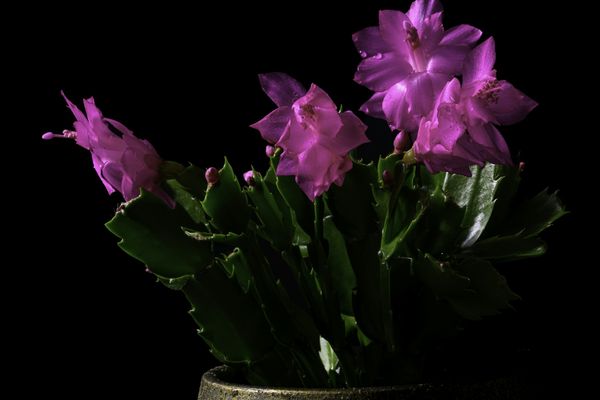Christmas Cactus Care Guide
How to grow and care for Christmas Cactus (Schlumbergera spp.)
The Schlumbergera spp., commonly known as the Christmas Cactus, is a vibrant and resilient indoor plant that blooms around the winter holidays, adding a splash of color to your home. Originating from the tropical rainforests of Brazil, these succulents thrive in humid conditions and are known for their long-lasting, tubular flowers. With the right care, they can be a beautiful, low-maintenance addition to any indoor plant collection.

Disclosure: This content includes affiliate links, which means we may earn a commission if you click on a link and make a purchase. As an Amazon Associate, we earn from qualifying purchases. This comes at no extra cost to you and helps offset the cost of running Leafwise. Please read our disclaimer for more info.
Table of Contents
Care
Light
Christmas Cactus thrives in bright, indirect light and should receive four to six hours of diffused sunlight per day. Avoid harsh direct sunlight, which can scorch the leaves. North- or east-facing windows are ideal locations.
Watering
Water the plant thoroughly but allow the top inch of soil to dry out between waterings. Avoid soggy conditions, which can lead to root rot. Reduce watering slightly after blooming and during flowering to support the plant’s natural cycle and promote better blooms.
Soil
Use a well-draining potting mix, preferably one formulated for cacti or succulents. Adding coarse sand or perlite improves drainage and aeration.
Temperature
Maintain temperatures between 60–70°F (15–21°C) most of the year. During active growth (April to September), slightly warmer conditions—up to 80°F (27°C)—are ideal. Avoid drafts, sudden temperature changes, and proximity to heat sources.
Humidity
Christmas Cactus prefers a humid environment. Increase humidity with a room humidifier or humidity tray.
Maintenance
Fertilizing
Feed monthly during spring and summer using a balanced, water-soluble fertilizer diluted to half strength. Apply in early spring and again in early summer. Stop fertilizing in the fall and provide nighttime temperatures around 50–55°F (10–13°C) for 6–8 weeks to trigger blooming.
Pruning
After the flowering period, pinch off a few stem segments to encourage branching. Pruning helps maintain a compact shape and promotes fuller growth.
Cleaning
Wipe the leaves occasionally with a soft, damp cloth or brush to remove dust. This improves photosynthesis and helps prevent pest infestations.
Repotting
Repot every 2–3 years or when the plant becomes root-bound. Signs include roots protruding from drainage holes, water pooling on the soil surface, or the plant becoming top-heavy. Repot in spring, after flowering, using fresh, well-draining soil and a pot with drainage holes.
Propagation
Christmas Cactus can be propagated easily from stem cuttings. Pinch off a segment with 2–3 jointed sections and let it dry for about 24 hours to callous. Plant in a well-draining mix and water lightly. Keep in bright, indirect light and expect root development within a few weeks.
Common Issues
Pests
Though typically pest-resistant, Christmas Cactus can occasionally be affected by aphids or spider mites. Look for sticky residue, distorted growth, or fine webbing. Treat using neem oil or insecticidal soap, repeating every 7–10 days as needed.
Diseases
Root rot is the most frequent disease, caused by overwatering and poor drainage. Symptoms include foul-smelling, mushy roots. Prevent by using a well-draining mix, containers with drainage holes, and allowing soil to dry between waterings.
Yellow Leaves
Yellowing leaves often result from overwatering, insufficient light, or nutrient deficiencies. Ensure the plant gets bright, indirect light, allow soil to dry between waterings, and resume fertilizing during the growing season if needed.
